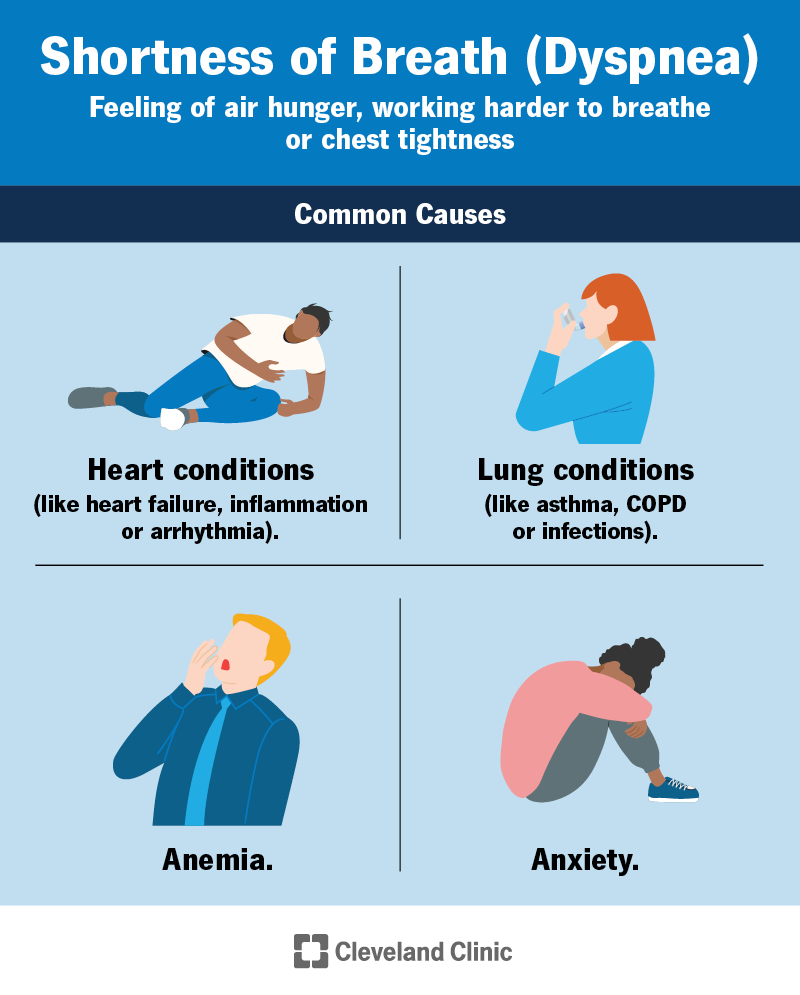Dyspnea, or shortness of breath, is the feeling that you can’t get enough air into your lungs. It might feel like your chest is tight, you’re gasping for air or you’re working harder to breathe. Heart and lung conditions are common causes of dyspnea.
Advertisement
Cleveland Clinic is a non-profit academic medical center. Advertising on our site helps support our mission. We do not endorse non-Cleveland Clinic products or services. Policy

Dyspnea (pronounced “DISP-nee-uh”) is the word healthcare providers use for feeling short of breath. You might describe it as not being able to get enough air (“air hunger”), chest tightness or working harder to breathe.
Advertisement
Cleveland Clinic is a non-profit academic medical center. Advertising on our site helps support our mission. We do not endorse non-Cleveland Clinic products or services. Policy
Shortness of breath is often a symptom of heart and lung problems. But it can also be a sign of other conditions like asthma, allergies or anxiety. Intense exercise or having a cold can also make you feel breathless.
Paroxysmal nocturnal dyspnea (PND) is a feeling like you can’t breathe an hour or two after falling asleep. Sighing dyspnea is when you sigh a lot after taking deep breaths in to try to relieve the feeling of dyspnea.
Dyspnea and shortness of breath are the same. Dyspnea is the medical term for the feeling of not being able to get enough air.
Acute and chronic dyspnea differ in how quickly they start and how long they last. They have different causes.
Acute dyspnea can come on quickly and doesn’t last very long (hours to days). Allergies, anxiety, exercise and illness (like the common cold or the flu) can cause acute dyspnea. More serious conditions, like a heart attack, sudden airway narrowing (anaphylaxis) or blood clot (pulmonary embolism) can also cause acute dyspnea.
Chronic dyspnea is shortness of breath that lasts a long time (several weeks or longer) or keeps coming back. Ongoing health conditions like asthma, heart failure and COPD can cause chronic dyspnea. Not getting enough exercise can also make you feel breathless all the time because your muscles are trying to get more oxygen.
Advertisement
As it has so many causes, shortness of breath is very common. But you might be more likely to get short of breath if you don’t get enough exercise or have:
Shortness of breath can feel different from person to person and depending on what’s causing it. Sometimes, it comes with other symptoms.
Some signs of dyspnea include:
Exercise, illness and health conditions can cause shortness of breath. The most common causes of dyspnea are heart and lung conditions.
Your heart and lungs work together to bring oxygen to your blood and tissues and remove carbon dioxide. If one or the other isn’t working right, you can end up with too little oxygen or too much carbon dioxide in your blood.
When this happens, your body tells you to breathe harder to get more oxygen in or carbon dioxide out. Anything that makes your body need more oxygen — like a good workout or being at high altitudes — can also make this happen.
Your brain can also get the message that your lungs aren’t working right. This might make you feel like you’re working harder to breathe or give you a feeling of tightness in your chest. Causes for this include:
Heart or lung disease and other conditions can cause shortness of breath.
Advertisement
To try to figure out what’s causing your dyspnea, your healthcare provider will perform a physical exam, including listening to your lungs with a stethoscope and taking your blood pressure. They’ll put a sensor on your finger to see how much oxygen you have in your blood.
They may also do additional testing, including:
Advertisement
How you treat shortness of breath depends on what’s causing it. If you have an underlying medical condition, you’ll need to address it for your symptoms to improve.
Treatments that can improve your breathing include:
Most people experience shortness of breath occasionally. You can usually treat what’s causing dyspnea, but it may come back, especially if you have an underlying condition.
You can help prevent shortness of breath by:
Advertisement
Contact a healthcare provider if you have severe shortness of breath or if your breathlessness interferes with your everyday activities. Sometimes, shortness of breath is a sign of a medical emergency that requires immediate treatment.
If you have a condition that makes you short of breath often, ask a healthcare provider if there are additional treatments to help you breathe better.
Dyspnea on its own usually isn’t dangerous, but sometimes, shortness of breath can be a sign of a life-threatening condition. Go to the nearest ER if you have:
When something “takes your breath away,” it’s usually a good thing. But the scary feeling of dyspnea is the kind of breathtaking no one wants to experience. If you have sudden or severe shortness of breath, especially if you’re also having other symptoms, like nausea, chest pain or blue skin, lips or nails, go to the nearest ER.
If you’re living with shortness of breath on a regular basis due to an underlying condition, talk to your healthcare provider about managing your symptoms. You might not be able to get rid of your symptoms completely, but sometimes, even small changes can make a big difference in your quality of life.
Whether you need stitches, a broken bone set or think your appendix might be causing your abdominal pain, Cleveland Clinic’s emergency medicine team is here to help.

Last reviewed on 11/11/2022.
Learn more about the Health Library and our editorial process.